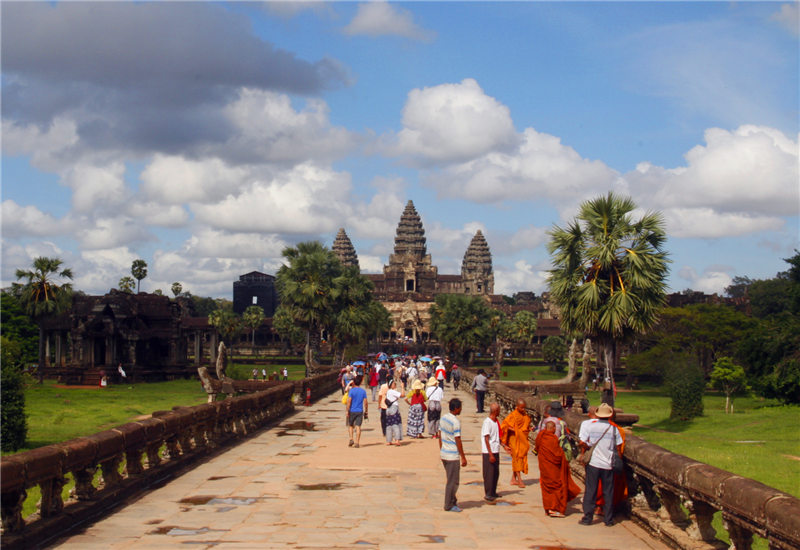Welcome to Facts Vibes! Today, we’re delving into the captivating world of Angkor Wat. Uncover the historical marvel and cultural significance of this ancient Khmer temple complex as we explore intriguing facts that will leave you in awe. Join us on this insightful journey through time and heritage.
Exploring the Fascinating History of Angkor Wat
The history of Angkor Wat is a captivating journey into the roots of Southeast Asian civilization. Built in the early 12th century by King Suryavarman II, this iconic temple complex stands as a testament to the grandeur and architectural prowess of the Khmer Empire. Its intricate carvings and towering spires are a reflection of the spiritual and cultural significance it held in ancient times. Situated in present-day Cambodia, Angkor Wat served as the center of a vast urban settlement covering over 400 square kilometers, making it one of the most extensive pre-industrial cities in the world.
The religious symbolism and artistic detailing of Angkor Wat are awe-inspiring, with its elaborate bas-reliefs depicting Hindu epics such as the Ramayana and the Mahabharata. The temple’s layout, aligned with astronomical observations, underscores the advanced knowledge of the Khmer people in fields like architecture and cosmology. Furthermore, the hydraulic infrastructure surrounding Angkor Wat, including reservoirs and canals, demonstrates the engineering ingenuity of the ancient Khmer society, allowing for sustainable agriculture and water management.
Over the centuries, Angkor Wat has endured periods of neglect, restoration, and conservation efforts, witnessing the ebb and flow of various dynasties and external influences. Today, it continues to stand as a symbol of national pride for Cambodia and a UNESCO World Heritage site, attracting visitors from around the globe who come to marvel at its historical and cultural significance.
The exploration of Angkor Wat’s history provides invaluable insights into the legacy of the Khmer Empire and the enduring impact of its architectural and artistic achievements. By delving into its fascinating past, we gain a deeper appreciation for the interconnectedness of history, culture, and human ingenuity.
Most popular facts
Angkor Wat is the largest religious monument in the world.
Yes, Angkor Wat is indeed the largest religious monument in the world.
It was built in the early 12th century by King Suryavarman II.
Sure! The structure was built in the early 12th century by King Suryavarman II.
The temple complex covers an area of over 400 acres.
The temple complex covers an area of over 400 acres.
Angkor Wat is dedicated to the Hindu god Vishnu, but later it became a Buddhist temple.
Angkor Wat is dedicated to the Hindu god Vishnu, but later it became a Buddhist temple.
The central tower of Angkor Wat represents Mount Meru, the home of the gods in Hindu mythology.
Yes, the central tower of Angkor Wat represents Mount Meru, the home of the gods in Hindu mythology.
The site is adorned with intricate carvings and bas-reliefs depicting Hindu epics.
The site is adorned with intricate carvings and bas-reliefs depicting Hindu epics.
Angkor Wat is a UNESCO World Heritage site and a symbol of Cambodia.
Angkor Wat is a UNESCO World Heritage site and a symbol of Cambodia.
The temple’s architecture reflects the Khmer Empire’s unique style and cultural influences.
The temple’s architecture reflects the Khmer Empire’s unique style and cultural influences.
The moat surrounding Angkor Wat serves both symbolic and practical purposes.
The moat surrounding Angkor Wat serves both symbolic and practical purposes.
Angkor Wat’s design is aligned with astronomical and celestial features.
Yes, Angkor Wat’s design is aligned with astronomical and celestial features.
The temple’s construction utilized sandstone blocks quarried from a mountain 50 kilometers away.
The temple’s construction utilized sandstone blocks quarried from a mountain 50 kilometers away.
Angkor Wat was once part of a sophisticated urban complex with canals, reservoirs, and other temples.
Angkor Wat was once part of a sophisticated urban complex with canals, reservoirs, and other temples.
The site has faced threats from looting, structural instability, and environmental damage.
The site has faced threats from looting, structural instability, and environmental damage.
Each year, millions of tourists visit Angkor Wat to marvel at its grandeur and historical significance.
Angkor Wat attracts millions of tourists annually due to its grandeur and historical significance.
Angkor Wat continues to be a source of national pride and an enduring symbol of Cambodia’s cultural heritage.
Angkor Wat is a source of national pride and an enduring symbol of Cambodia’s cultural heritage.
In conclusion, Angkor Wat stands as a remarkable testament to the ingenuity and architectural prowess of the ancient Khmer civilization. Its grandeur and historical significance continue to inspire and awe visitors from around the world, making it a must-see destination for anyone with an appreciation for history and culture.
